Highly Sensitive Hydrogen Sensing Based on Tunable Diode Laser Absorption Spectroscopy with a 2.1 μm Diode Laser
Abstract
:1. Introduction
2. Principle
2.1. Principle of TDLAS Technique
2.2. The Selection of Laser Source
- A laser with a suitable output power. A moderate output power is advantageous in obtaining a high signal-to-noise ratio (SNR).
- A single-longitudinal-mode and narrow line width output can improve the selectivity and sensitivity of system detection.
- A stable mode and no mode-hopping output, which can reduce the noise caused by mode competition and improve the stability of system detection.
- The working wavelength can be quickly tuned, and the tuning range is wide enough to ensure that the spectral absorption range of the target gas can be covered. The requirements of fast response and high-speed data acquisition can be met. The output wavelength range of the laser determines the species and quantity of detectable gases.
- High beam quality, that is, a small divergence angle and ideal spot shape, which facilitates beam coupling in the optical system and reduces optical noise.
- A source that is insensitive to changes in environmental conditions. External environment temperature, humidity, and pressure changes will not significantly influence the output performance of the laser.
- The volume, weight, and power dissipation of the laser should be small, and the lifetime should be long so as to meet the requirements of engineering application.
2.3. The Selection of H2 Absorption Lines
- The line strength of the selected absorption line should be as large as possible.
- The selected gas absorption lines minimize the degree of overlap with other gas absorption lines.
- It should be ensured that a suitable laser source is available to excite the selected gas absorption lines.
2.4. The Selection of Multipass Gas Cell
2.5. WMS and Harmonic Demodulation Technique
2.6. Allan Variance
3. Experimental Setup
4. Results and Discussion
5. Conclusions
Author Contributions
Funding
Institutional Review Board Statement
Informed Consent Statement
Data Availability Statement
Conflicts of Interest
References
- Penner, S.S. Fossil-fuel resources and CO2 production from combustion. Energy 1991, 16, 1417–1419. [Google Scholar] [CrossRef]
- Midilli, A.; Ay, M.; Dincer, I.; Rosen, M.A. On hydrogen and hydrogen energy strategies I: Current status and needs. Renew. Sustain. Energ. Rev. 2005, 9, 255–271. [Google Scholar] [CrossRef]
- Mazloomi, K.; Gomes, C. Hydrogen as an energy carrier: Prospects and challenges. Renew. Sustain. Energy Rev. 2012, 16, 3024–3033. [Google Scholar] [CrossRef]
- Arora, K.; Puri, N.K. Electrophoretically deposited nanostructured PdO thin film for room temperature amperometric H2 sensing. Vacuum 2018, 154, 302–308. [Google Scholar] [CrossRef]
- Bin Taher, M.I.; Halfaya, Y.; Alrammouz, R.; Lazerges, M.; Randi, A.; Moudakir, T.; Sama, N.Y.; Guermont, T.; Pelissier, N.; Pichler, T.; et al. High electron mobility transistor-based hydrogen sensor using ITO as a sensing layer. In Proceedings of the 20th IEEE Sensors Conference, Electr Network, Sydney, Australia, 31 October–4 November 2021. [Google Scholar]
- Yi, J.X.; Zhang, H.; Zhang, Z.B.; Chen, D.D. Hierarchical porous hollow SnO2 nanofiber sensing electrode for high performance potentiometric H2 sensor. Sens. Actuator B-Chem. 2018, 268, 456–464. [Google Scholar] [CrossRef]
- Yang, F.; Kung, S.C.; Cheng, M.; Hemminger, J.C.; Penner, R.M. Smaller is faster and more sensitive: The effect of wire size on the detection of hydrogen by single palladium nanowires. ACS Nano 2010, 4, 5233–5244. [Google Scholar] [CrossRef]
- Hassan, K.; Chung, G.S. Catalytically activated quantum-size Pt/Pd bimetallic core-shell nanoparticles decorated on ZnO nanorod clusters for accelerated hydrogen gas detection. Sens. Actuator B-Chem. 2017, 239, 824–833. [Google Scholar] [CrossRef]
- Hashtroudi, H.; Yu, A.M.; Juodkazis, S.; Shafiei, M. Ultra-sensitive photo-induced hydrogen gas sensor based on two-dimensional CeO2-Pd-PDA/rGO heterojunction nanocomposite. Nanomaterials 2022, 12, 1628. [Google Scholar] [CrossRef]
- Li, Z.J.; Yan, S.N.; Wu, Z.L.; Li, H.; Wang, J.Q.; Shen, W.Z.; Wang, Z.G.; Fu, Y.Q. Hydrogen gas sensor based on mesoporous In2O3 with fast response/recovery and ppb level detection limit. Int. J. Hydrogen Energy 2018, 43, 22746–22755. [Google Scholar] [CrossRef]
- Hossain, M.K.; Drmosh, Q.A. Noble metal-decorated nanostructured Zinc Oxide: Strategies to advance chemiresistive hydrogen gas sensing. Chem. Rec. 2022, 22, e202200090. [Google Scholar]
- Yoo, S.M.; Sharma, B.; Kim, J.S. Boron nitride nanotubes (BNNTs) decorated Pd-ternary alloy (Pd63·2Ni34·3CO2.5) for H2 sensing. Int. J. Hydrogen Energy 2021, 46, 12263–12270. [Google Scholar] [CrossRef]
- Lin, K.W.; Chen, H.I.; Chuang, H.M.; Chen, C.Y.; Lu, C.T.; Cheng, C.C.; Liu, W.C. Characteristics of Pd/InGaP Schottky diodes hydrogen sensors. IEEE Sens. J. 2004, 4, 72–79. [Google Scholar] [CrossRef]
- Al-Ahmadi, N.A. Metal oxide semiconductor-based Schottky diodes: A review of recent advances. Mater. Res. Express 2020, 7, 032001. [Google Scholar] [CrossRef]
- Chauhan, P.S.; Bhattacharya, S. Hydrogen gas sensing methods, materials, and approach to achieve parts per billion level detection: A review. Int. J. Hydrogen Energy 2019, 44, 26076–26099. [Google Scholar] [CrossRef]
- Boudjiet, M.T.; Bertrand, J.; Pellet, C.; Dufour, I. New characterization methods for monitoring small resonant frequency variation: Experimental tests in the case of hydrogen detection with uncoated silicon microcantilever-based sensors. Sens. Actuator B-Chem. 2014, 199, 269–276. [Google Scholar] [CrossRef]
- Zhou, L.J.; Kato, F.; Nakamura, N.; Oshikane, Y.; Nagakubo, A.; Ogi, H. MEMS hydrogen gas sensor with wireless quartz crystal resonator. Sens. Actuator B-Chem. 2021, 334, 129651. [Google Scholar] [CrossRef]
- Sil, D.; Hines, J.; Udeoyo, U.; Borguet, E. Palladium nanoparticle-based surface acoustic wave hydrogen sensor. ACS Appl. Mater. Interfaces 2015, 7, 5709–5714. [Google Scholar] [CrossRef]
- Wan, J.K.S.; Ioffe, M.S.; Depew, M.C. A novel acoustic sensing system for on-line hydrogen measurements. Sens. Actuator B-Chem. 1996, 32, 233–237. [Google Scholar] [CrossRef]
- Liao, C.R.; Xiong, C.; Zhao, J.L.; Zou, M.Q.; Zhao, Y.Y.; Li, B.Z.; Ji, P.; Cai, Z.H.; Gan, Z.S.; Wang, Y.; et al. Design and realization of 3D printed fiber-tip microcantilever probes applied to hydrogen sensing. Light Sci. Appl. 2022, 3, 1–11. [Google Scholar] [CrossRef]
- Cai, S.S.; Gonzalez-Vila, A.; Zhang, X.J.; Guo, T.; Caucheteur, C. Palladium-coated plasmonic optical fiber gratings for hydrogen detection. Opt. Lett. 2019, 44, 4483–4486. [Google Scholar] [CrossRef]
- Ma, Y.F.; Lewicki, R.; Razeghi, M.; Tittel, F.K. QEPAS based ppb-level detection of CO and N2O using a high power CW DFB-QCL. Opt. Express 2013, 21, 1008–1019. [Google Scholar] [CrossRef]
- Zifarelli, A.; De Palo, R.; Patimisco, P.; Giglio, M.; Sampaolo, A.; Blaser, S.; Butet, J.; Landry, O.; Müller, A.; Spagnolo, V. Multi-gas quartz-enhanced photoacoustic sensor for environmental monitoring exploiting a Vernier effect-based quantum cascade laser. Photoacoustics 2022, 28, 100401. [Google Scholar] [CrossRef]
- Dello Russo, S.; Zifarelli, A.; Patimisco, P.; Sampaolo, A.; Wei, T.T.; Wu, H.P.; Dong, L.; Spagnolo, V. Light-induced thermo-elastic effect in quartz tuning forks exploited as a photodetector in gas absorption spectroscopy. Opt. Express 2020, 28, 19074–19084. [Google Scholar] [CrossRef] [PubMed]
- He, Y.; Ma, Y.F.; Tong, Y.; Yu, X.; Tittel, F.K. Ultra-high sensitive light-induced thermoelastic spectroscopy sensor with a high Q-factor quartz tuning fork and a multipass cell. Opt. Lett. 2019, 44, 1904–1907. [Google Scholar] [CrossRef]
- Ma, Y.F.; He, Y.; Zhang, L.G.; Yu, X.; Zhang, J.B.; Sun, R.; Tittel, F.K. Ultra-high sensitive acetylene detection using quartz-enhanced photoacoustic spectroscopy with a fiber amplified diode laser and a 30.72 kHz quartz tuning fork. Appl. Phys. Lett. 2017, 110, 31107. [Google Scholar] [CrossRef]
- Ma, Y.F.; He, Y.; Patimisco, P.; Sampaolo, A.; Qiao, S.D.; Yu, X.; Tittel, F.K.; Spagnolo, V. Ultra-high sensitive trace gas detection based on light-induced thermoelastic spectroscopy and a custom quartz tuning fork. Appl. Phys. Lett. 2020, 116, 11103. [Google Scholar] [CrossRef]
- Wang, Z.; Wang, Q.; Zhang, H.; Borri, S.; Galli, I.; Sampaolo, A.; Patimisco, P.; Spagnolo, V.L.; De Natale, P.; Ren, W. Doubly resonant sub-ppt photoacoustic gas detection with eight decades dynamic range. Photoacoustics 2022, 27, 100387. [Google Scholar] [CrossRef]
- He, Y.; Ma, Y.F.; Tong, Y.; Yu, X.; Peng, Z.F.; Gao, J.; Tittel, F.K. Long distance, distributed gas sensing based on micro-nano fiber evanescent wave quartz-enhanced photoacoustic spectroscopy. Appl. Phys. Lett. 2017, 111, 241102. [Google Scholar] [CrossRef]
- Sgobba, F.; Sampaolo, A.; Patimisco, P.; Giglio, M.; Menduni, G.; Ranieri, A.C.; Hoelzl, C.; Rossmadl, H.; Brehm, C.; Mackowiak, V.; et al. Compact and portable quartz-enhanced photoacoustic spectroscopy sensor for carbon monoxide environmental monitoring in urban areas. Photoacoustics 2022, 25, 100318. [Google Scholar] [CrossRef] [PubMed]
- Lang, Z.T.; Qiao, S.D.; He, Y.; Ma, Y.F. Quartz tuning fork-based demodulation of an acoustic signal induced by photo-thermo-elastic energy conversion. Photoacoustics 2021, 22, 100272. [Google Scholar] [CrossRef]
- Qiao, S.D.; Sampaolo, A.; Patimisco, P.; Spagnolo, V.; Ma, Y.F. Ultra-highly sensitive HCl-LITES sensor based on a low-frequency quartz tuning fork and a fiber-coupled multi-pass cell. Photoacoustics 2022, 27, 100381. [Google Scholar] [CrossRef]
- Qiao, S.D.; He, Y.; Ma, Y.F. Trace gas sensing based on single-quartz-enhanced photoacoustic-photothermal dual spectroscopy. Opt. Lett. 2021, 46, 2449–2452. [Google Scholar] [CrossRef]
- Ma, Y.F.; Hu, Y.Q.; Qiao, S.D.; He, Y.; Tittel, F.K. Trace gas sensing based on multi-quartz-enhanced photothermal spectroscopy. Photoacoustics 2020, 20, 100206. [Google Scholar] [CrossRef]
- Hu, L.E.; Zheng, C.T.; Zhang, M.H.; Zheng, K.Y.; Zheng, J.; Song, Z.W.; Li, X.Y.; Zhang, Y.; Wang, Y.D.; Tittel, F.K. Long-distance in-situ methane detection using near-infrared light-induced thermo-elastic spectroscopy. Photoacoustics 2021, 21, 100230. [Google Scholar] [CrossRef] [PubMed]
- Zhang, Q.D.; Chang, J.; Cong, Z.H.; Wang, Z.L. Application of quartz tuning fork in photodetector based on photothermal effect. IEEE Photonics Technol. Lett. 2019, 31, 1592–1595. [Google Scholar] [CrossRef]
- Ma, Y.F.; Hu, Y.Q.; Qiao, S.D.; Lang, Z.T.; Liu, X.N.; He, Y.; Spagnolo, V. Quartz tuning forks resonance frequency matching for laser spectroscopy sensing. Photoacoustics 2022, 25, 100329. [Google Scholar] [CrossRef]
- Craig, I.M.; Taubman, M.S.; Bernacki, B.E.; Stahl, R.D.; Schiffern, J.T.; Myers, T.L.; Cannon, B.D.; Phillips, M.C. Tunable Diode Laser Absorption Spectrometer for detection of hydrogen fluoride gas at ambient pressure. In Proceedings of the Conference on Lasers and Electro-Optics (CLEO), San Jose, CA, USA, 8–13 June 2014. [Google Scholar]
- Dong, L.; Tittel, F.K.; Li, C.G.; Sanchez, N.P.; Wu, H.P.; Zheng, C.T.; Yu, Y.J.; Sampaolo, A.; Griffin, R.J. Compact TDLAS based sensor design using interband cascade lasers for mid-IR trace gas sensing. Opt. Express 2016, 24, A528–A535. [Google Scholar] [CrossRef] [PubMed]
- Zhou, X.; Yu, J.; Wang, L.; Gao, Q.; Zhang, Z.G. Sensitive detection of oxygen using a diffused integrating cavity as a gas absorption cell. Sens. Actuator B-Chem. 2017, 241, 1076–1081. [Google Scholar] [CrossRef]
- Avetisov, V.; Bjoroey, O.; Wang, J.; Geiser, P.; Paulsen, K.G. Hydrogen sensor based on tunable diode laser absorption spectroscopy. Sensors 2019, 19, 5313. [Google Scholar] [CrossRef] [PubMed]
- Werle, P. A review of recent advances in semiconductor laser based gas monitors. Spectroc. Acta Pt. A-Mol. Biomol. Spectr. 1998, 54, 197–236. [Google Scholar] [CrossRef]
- Li, C.L.; Guo, X.Q.; Ji, W.H.; Wei, J.L.; Qiu, X.B.; Ma, W.G. Etalon fringe removal of tunable diode laser multi-pass spectroscopy by wavelet transforms. Opt. Quantum Electron. 2018, 50, 275. [Google Scholar] [CrossRef]
- Thomazy, D.; So, S.; Kosterev, A.; Lewicki, R.; Dong, L.; Sani, A.A.; Tittel, F.K. Low-power laser-based carbon monoxide sensor for fire and post-fire detection using a compact Herriott multipass cell. In Proceedings of the Conference on Quantum Sensing and Nanophotonic Devices VII, San Jose, CA, USA, 24–28 January 2010. [Google Scholar]
- Guo, Y.C.; Qiu, X.B.; Li, N.; Feng, S.L.; Cheng, T.; Liu, Q.Q.; He, Q.S.; Kan, R.F.; Yang, H.N.; Li, C.L. A portable laser-based sensor for detecting H2S in domestic natural gas. Infrared Phys. Technol. 2020, 105, 103153. [Google Scholar] [CrossRef]
- Krzempek, K.; Lewicki, R.; Nähle, L.; Fischer, M.; Koeth, J.; Belahsene, S.; Rouillard, Y.; Worschech, L.; Tittel, F.K. Continuous wave, distributed feedback diode laser based sensor for trace-gas detection of ethane. Appl. Phys. B-Lasers Opt. 2012, 106, 251–255. [Google Scholar] [CrossRef]
- Shao, L.G.; Fang, B.; Zheng, F.; Qiu, X.B.; He, Q.S.; Wei, J.L.; Li, C.L.; Zhao, W.X. Simultaneous detection of atmospheric CO and CH4 based on TDLAS using a single 2.3 μm DFB laser. Spectroc. Acta Pt. A-Mol. Biomol. Spectr. 2019, 222, 117118. [Google Scholar] [CrossRef]
- Lin, S.; Chang, J.; Sun, J.C.; Xu, P. Improvement of the detection sensitivity for Tunable Diode Laser Absorption Spectroscopy: A Review. Front. Phys. 2022, 10, 853966. [Google Scholar] [CrossRef]
- Werle, P.; Mücke, R.; Slemr, F. The limits of signal averaging in atmospheric trace-gas monitoring by tunable diode-laser absorption spectroscopy (TDLAS). Appl. Phys. B 1993, 57, 131–139. [Google Scholar] [CrossRef]
- Gordon, I.E.; Rothman, L.S.; Hargreaves, R.J.; Hashemi, R.; Karlovets, E.V.; Skinner, F.M.; Conway, E.K.; Hill, C.; Kochanov, R.V.; Tan, Y.; et al. The HITRAN2020 molecular spectroscopic database. J. Quant. Spectrosc. Radiat. Transf. 2022, 277, 107949. [Google Scholar] [CrossRef]
- Ma, Y.F.; He, Y.; Yu, X.; Chen, C.; Sun, R.; Tittel, F.K. HCl ppb-level detection based on QEPAS sensor using a low resonance frequency quartz tuning fork. Sens. Actuators B 2016, 233, 388–393. [Google Scholar] [CrossRef]
- Ma, Y.F.; Feng, W.; Qiao, S.D.; Zhao, Z.X.; Gao, S.F.; Wang, Y.Y. Hollow-core anti-resonant fiber based light-induced thermoelastic spectroscopy for gas sensing. Opt. Express 2022, 30, 18836–18844. [Google Scholar] [CrossRef]
- Ma, Y.F.; He, Y.; Tong, Y.; Yu, X.; Tittel, F.K. Quartz-tuning-fork enhanced photothermal spectroscopy for ultra-high sensitive trace gas detection. Opt. Express 2018, 26, 32103–32110. [Google Scholar] [CrossRef]
- Zhang, Z.H.; Zhang, F.B.; Xu, B.; Xie, H.Q.; Fu, B.T.; Lu, X.; Zhang, N.; Yu, S.P.; Yao, J.P.; Cheng, Y.; et al. High-sensitivity gas detection with air-lasing-assisted coherent Raman spectroscopy. Ultrafast Sci. 2022, 2022, 9761458. [Google Scholar] [CrossRef]
- E, Y.W.; Zhang, L.L.; Tcypkin, A.; Kozlov, S.; Zhang, C.L.; Zhang, X.C. Broadband THz sources from gases to liquids. Ultrafast Sci. 2021, 2021, 9892763. [Google Scholar] [CrossRef]
- Guo, Z.N.; Ge, P.P.; Fang, Y.Q.; Dou, Y.K.; Yu, X.Y.; Wang, J.G.; Gong, Q.H.; Liu, Y.Q. Probing molecular frame wigner time delay and electron wavepacket phase structure of CO molecule. Ultrafast Sci. 2022, 2022, 9802917. [Google Scholar] [CrossRef]
- Fu, Y.; Cao, J.C.; Yamanouchi, K.; Xu, H.L. Air-laser-based standoff coherent Raman spectrometer. Ultrafast Sci. 2022, 2022, 9867028. [Google Scholar] [CrossRef]
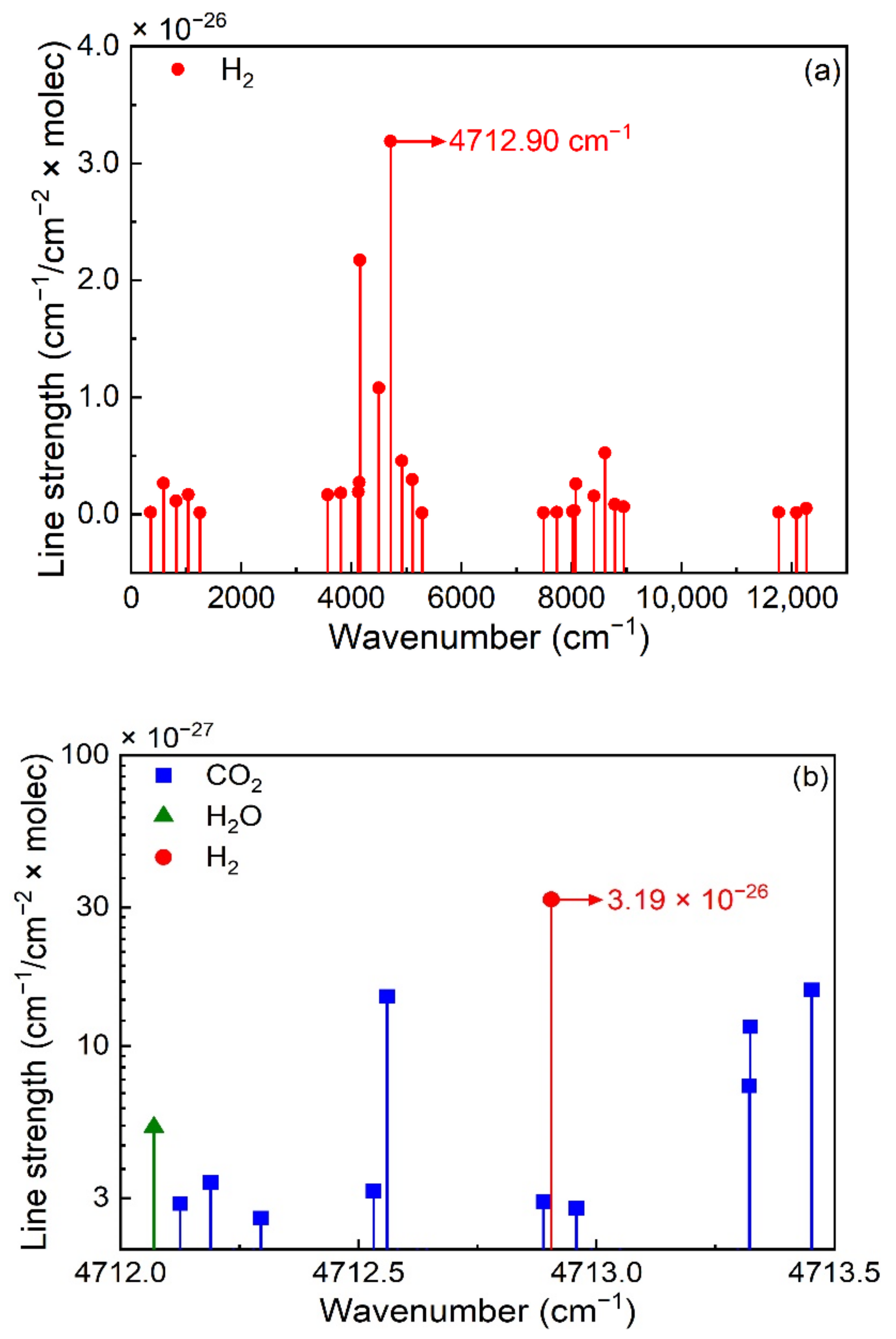
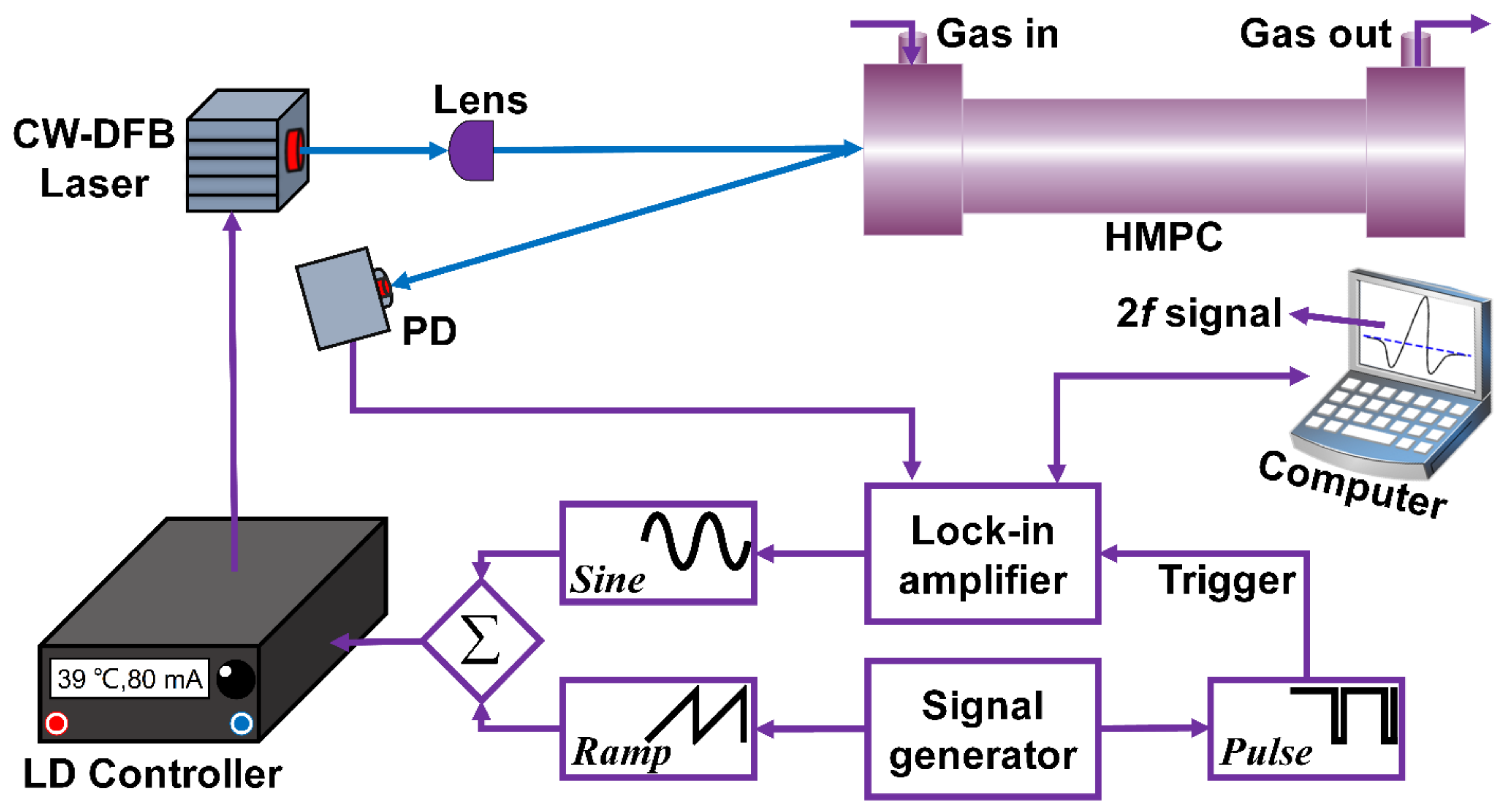

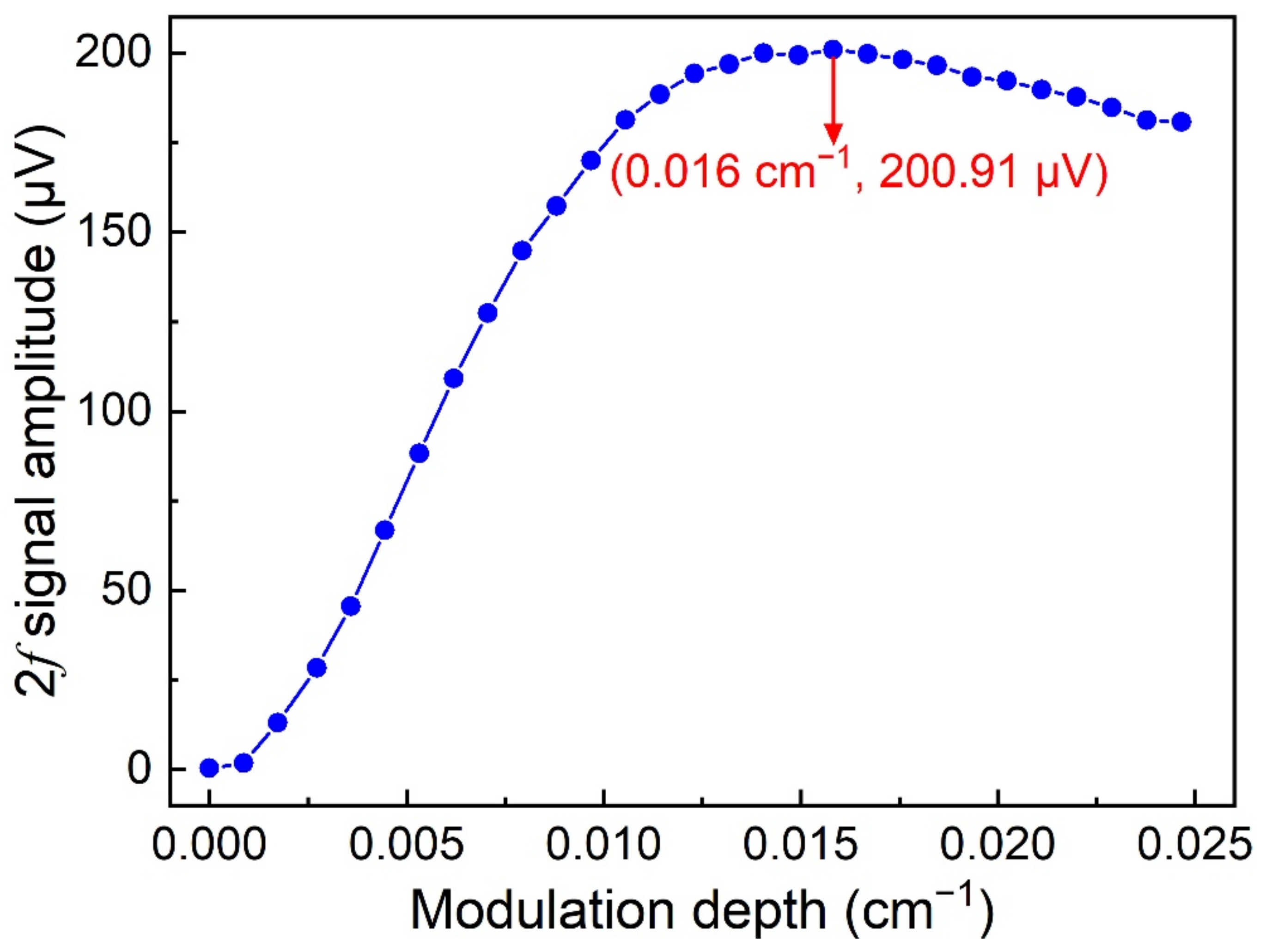

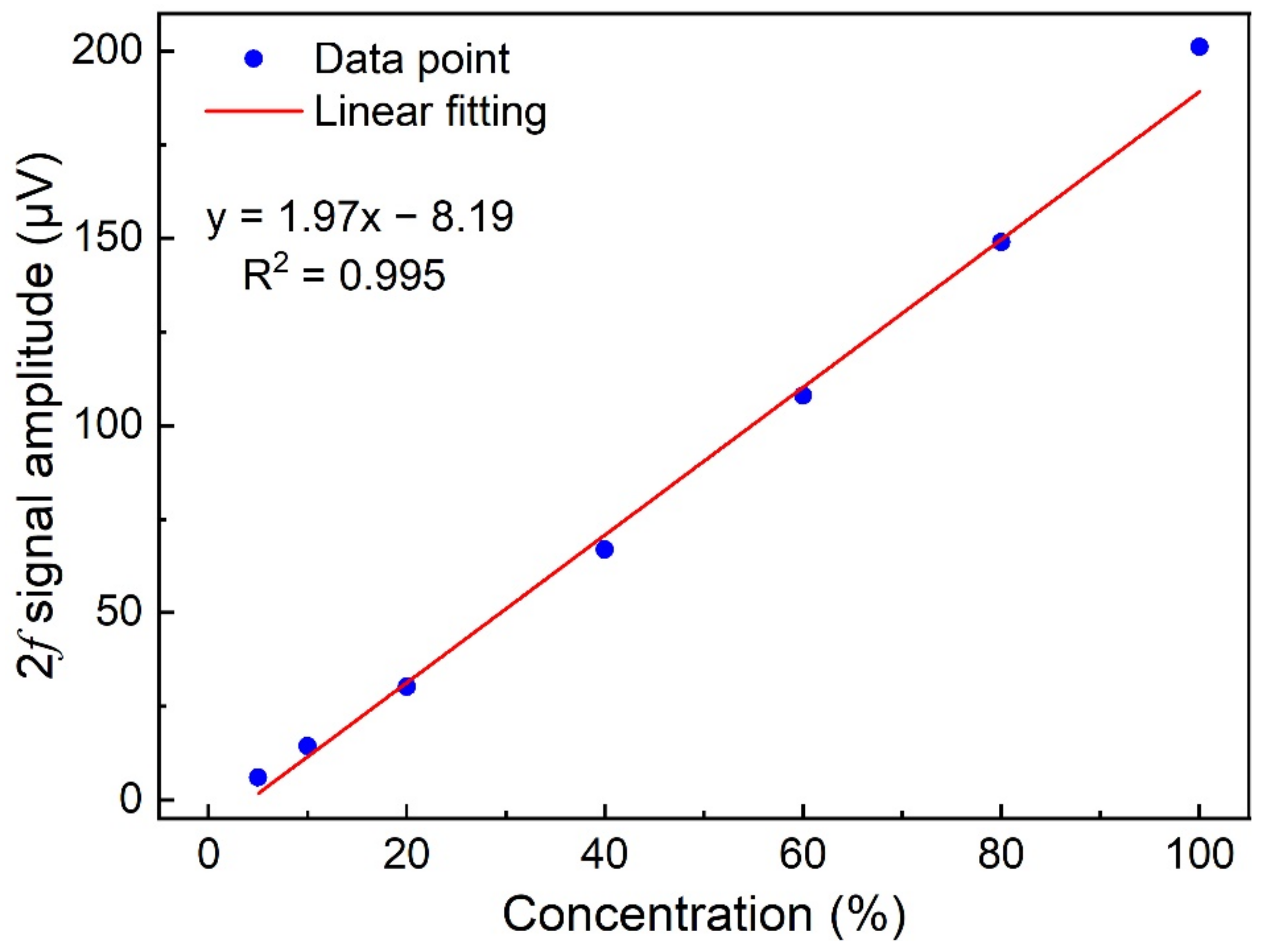

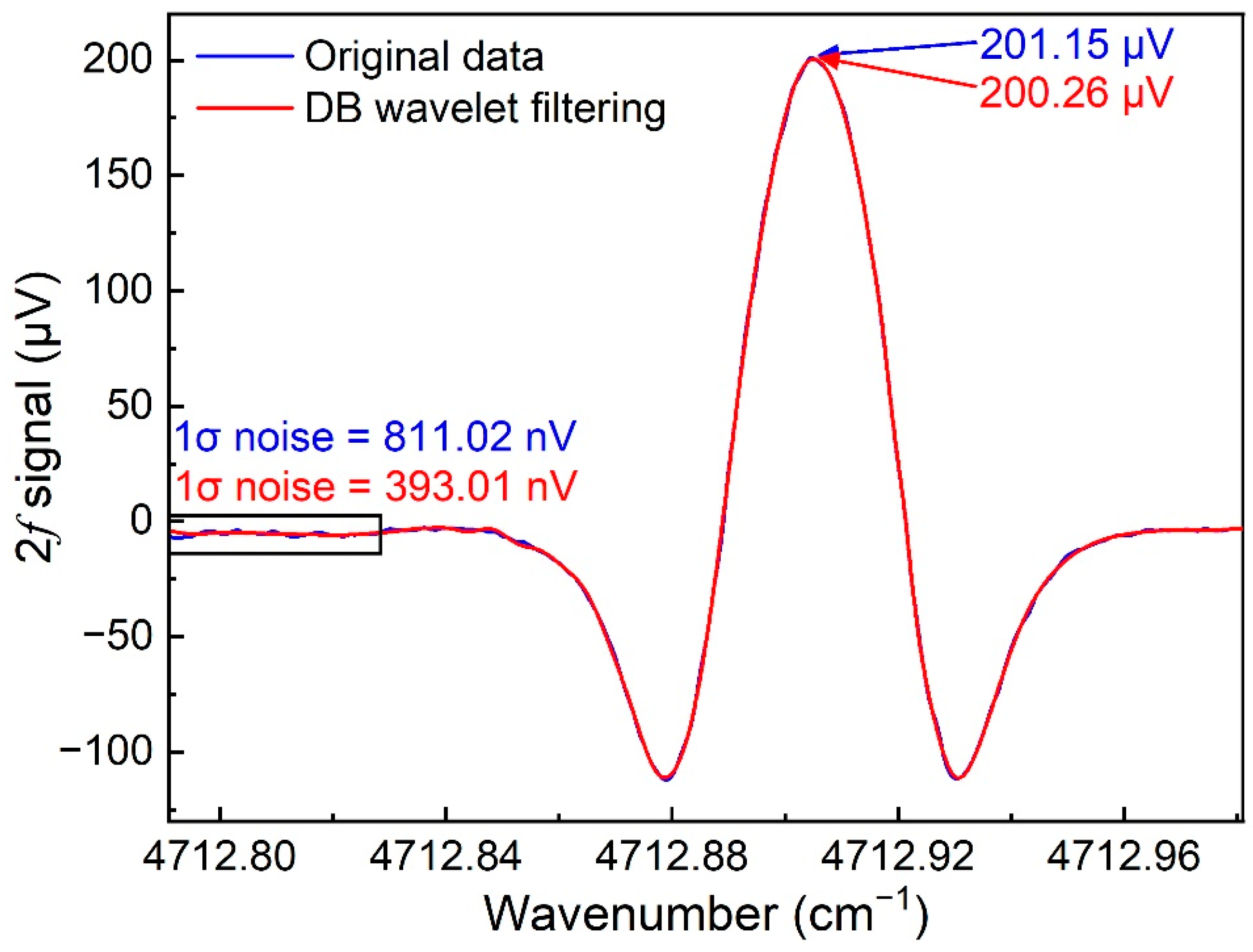
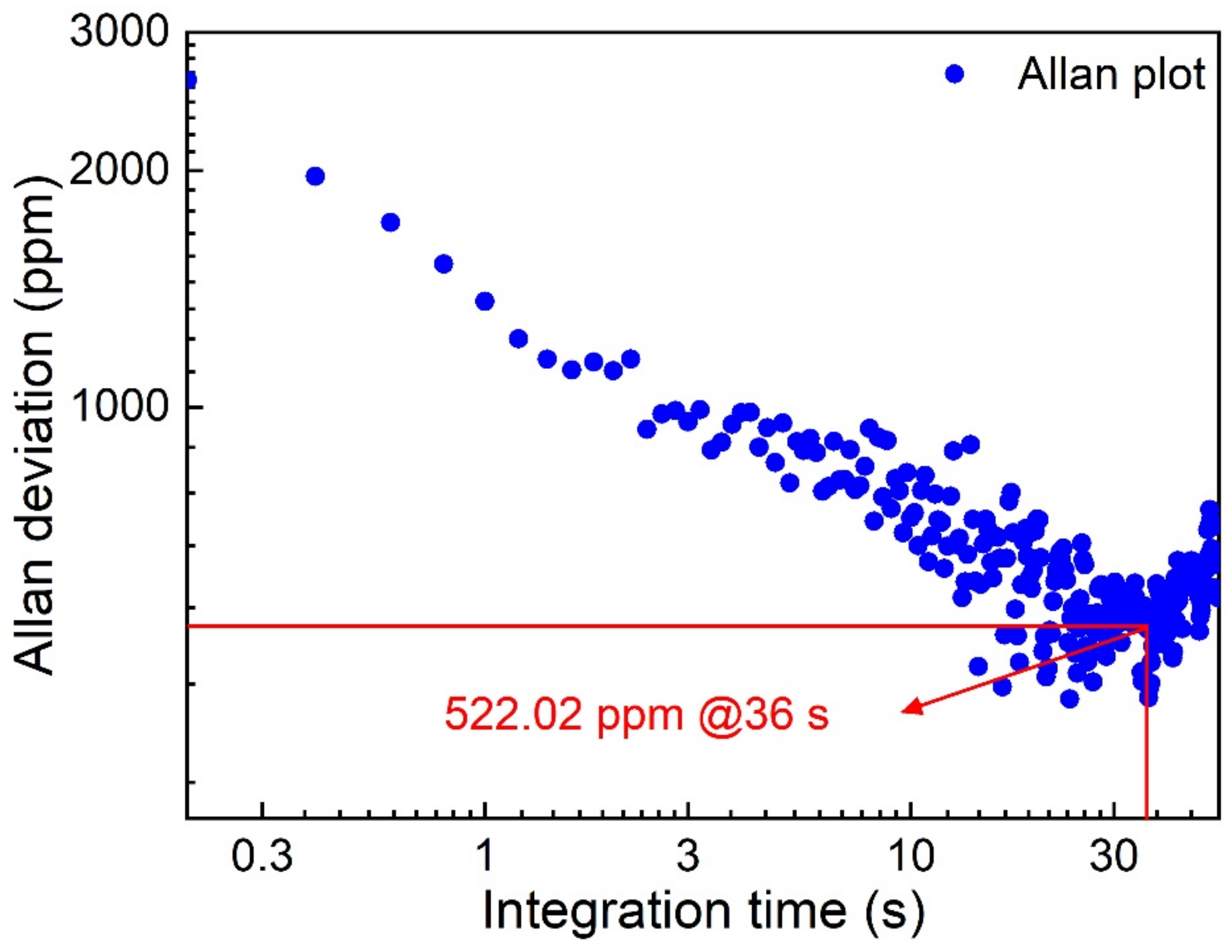
Publisher’s Note: MDPI stays neutral with regard to jurisdictional claims in published maps and institutional affiliations. |
© 2022 by the authors. Licensee MDPI, Basel, Switzerland. This article is an open access article distributed under the terms and conditions of the Creative Commons Attribution (CC BY) license (https://creativecommons.org/licenses/by/4.0/).
Share and Cite
Liang, T.; Qiao, S.; Liu, X.; Ma, Y. Highly Sensitive Hydrogen Sensing Based on Tunable Diode Laser Absorption Spectroscopy with a 2.1 μm Diode Laser. Chemosensors 2022, 10, 321. https://doi.org/10.3390/chemosensors10080321
Liang T, Qiao S, Liu X, Ma Y. Highly Sensitive Hydrogen Sensing Based on Tunable Diode Laser Absorption Spectroscopy with a 2.1 μm Diode Laser. Chemosensors. 2022; 10(8):321. https://doi.org/10.3390/chemosensors10080321
Chicago/Turabian StyleLiang, Tiantian, Shunda Qiao, Xiaonan Liu, and Yufei Ma. 2022. "Highly Sensitive Hydrogen Sensing Based on Tunable Diode Laser Absorption Spectroscopy with a 2.1 μm Diode Laser" Chemosensors 10, no. 8: 321. https://doi.org/10.3390/chemosensors10080321
APA StyleLiang, T., Qiao, S., Liu, X., & Ma, Y. (2022). Highly Sensitive Hydrogen Sensing Based on Tunable Diode Laser Absorption Spectroscopy with a 2.1 μm Diode Laser. Chemosensors, 10(8), 321. https://doi.org/10.3390/chemosensors10080321







